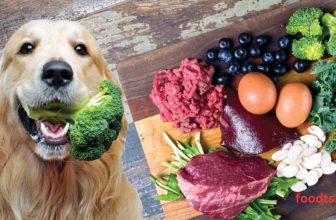What is the Best Dry Dog Food? Best Vet-Reviewed Guide

What is the Best Dry Dog Food: Providing your dog with high-quality dry food is essential for maintaining good health, supporting their immune system, and ensuring they have enough energy throughout the day. A well-balanced diet can contribute to longevity, prevent diseases, and enhance your dog’s overall well-being. With countless brands and varieties on the market, selecting the right one can be overwhelming. This guide will help you understand what makes the best dry dog food and recommend top choices based on different dietary needs.
Key Factors to Consider in the Best Dry Dog Food
When choosing the best dry dog food, it’s essential to evaluate these key factors:
Protein Content: Why High Protein Matters
Dogs are primarily carnivorous, so their diet should be rich in animal protein. Protein helps maintain muscle mass, repair tissues, and support overall health. Look for high-quality protein sources such as chicken, beef, lamb, fish, and turkey.

Benefits of High-Protein Diets:
- Supports lean muscle development
- Helps maintain energy levels
- Promotes a healthy coat and skin
- Aids in recovery after physical activity
- Improves overall metabolic function
Grain vs. Grain-Free: Which is Better?
Grain-free diets have gained popularity, but are they truly necessary? If your dog has grain allergies, a grain-free diet may help. Otherwise, whole grains like brown rice, barley, and oats provide valuable nutrients and fiber for digestive health.
Pros of Grain-Free Diets:
- Ideal for dogs with grain allergies or sensitivities
- Often contains higher protein content
- Can reduce bloating and digestive issues
Cons of Grain-Free Diets:
- Some studies suggest a link to heart disease in dogs
- Can be more expensive
- May lack certain essential nutrients found in grains
Essential Nutrients for a Balanced Diet

A well-balanced dry dog food should include:
- Omega-3 and Omega-6 fatty acids for a healthy coat and skin
- Fiber for proper digestion and gut health
- Vitamins and minerals such as Vitamin A, Vitamin E, and calcium for strong bones and immune support
- Probiotics for digestive balance and immune function
- Glucosamine and chondroitin to support joint health in aging dogs
Food Allergies & Sensitivities: What to Avoid
Some common allergens in dog food include corn, wheat, soy, and artificial additives. If your dog has a sensitive stomach, consider hypoallergenic formulas with limited ingredients.
Signs of Food Allergies in Dogs:
- Excessive scratching or skin irritation
- Chronic ear infections
- Vomiting or diarrhea
- Excessive licking of paws
- Loss of appetite or behavioral changes
Best Dry Dog Food Options for Different Needs
Dogs have different nutritional needs based on their age, breed, and health condition. Here are the top choices:
Best High-Protein Dry Dog Food for Active Dogs
- ORIJEN Amazing Grains Six Fish Recipe – Rich in animal protein, ideal for highly active dogs.
- Purina Pro Plan High Protein – Features real meat as the first ingredient for strong muscles.
Best Grain-Free Dry Dog Food for Sensitive Stomachs
- Taste of the Wild Pacific Stream – Contains high-quality fish protein and is free from grains.
- Blue Buffalo Life Protection Formula – Includes natural ingredients and probiotics for digestive health.
Best Budget-Friendly Dry Dog Food for Everyday Feeding

- Pedigree Complete Nutrition – Affordable and provides balanced nutrition.
- Iams Proactive Health – Offers quality ingredients at a reasonable price.
Vet-Recommended Dry Dog Food Brands
- Hill’s Science Diet Sensitive Stomach – Formulated for dogs with digestion issues.
- Purina ONE SmartBlend Lamb & Rice – A well-balanced option for adult dogs.
Best Dry Dog Food for Puppies
- Purina Pro Plan Puppy Formula – Supports brain development and a healthy immune system.
- Diamond Naturals Puppy – Contains DHA and antioxidants for growing pups.
Best Dry Dog Food for Senior Dogs
- Nutrish Real Chicken & Veggies Recipe – Provides joint support for aging dogs.
- Blue Buffalo Senior Life Protection – Features antioxidants for immune health.
What Ingredients to Look for (and Avoid) in Dry Dog Food?
To ensure your dog’s optimal health, look for these ingredients: ✅ Good Ingredients: Real meat, fish oil, sweet potatoes, probiotics, and whole grains. ❌ Avoid: Artificial preservatives, fillers, corn syrup, excessive salt, and sugar.
Why Artificial Additives Are Harmful
Some commercial dog foods contain artificial colors, flavors, and preservatives, which can lead to long-term health issues, including allergies and digestive disorders. Always opt for foods with natural preservatives like tocopherols (Vitamin E).
How to Transition Your Dog to a New Dry Food?

Switching your dog’s food too quickly can cause digestive upset. Follow this 7–10 day transition plan:
- Days 1–3: 25% new food, 75% old food.
- Days 4–6: 50% new food, 50% old food.
- Days 7–9: 75% new food, 25% old food.
- Day 10: 100% new food.
How to Store Dry Dog Food for Freshness?
Proper storage helps maintain nutritional value and prevents spoilage. Follow these tips:
- Store in an airtight container
- Keep in a cool, dry place
- Avoid direct sunlight
- Use within the expiration date
Frequently Asked Questions: What is the Best Dry Dog Food
Q1: What is the healthiest dry dog food?
A1: The healthiest option depends on your dog’s specific needs, but brands like ORIJEN, Purina Pro Plan, and Hill’s Science Diet are highly recommended by veterinarians.
Q2: Can I mix dry food with wet food?
A2: Yes! Mixing dry and wet food can provide additional hydration and flavor variety. It can also help picky eaters enjoy their meals more.
Q3: How do I know if my dog is allergic to dry food?
A3: Common signs of food allergies include itching, skin redness, ear infections, and digestive issues. If you suspect an allergy, consult your vet for dietary testing.
Q4: How often should I feed my dog dry food?
A4: It depends on their age and activity level. Puppies generally require 3-4 meals per day, while adult dogs do well with 2 meals.
Q5: Can dry dog food go bad?
A5: Yes. Always store kibble in an airtight container in a cool, dry place to maintain freshness and prevent contamination.
Final Thoughts
Choosing the best dry dog food requires understanding your dog’s specific nutritional needs. Whether you’re looking for high-protein options, grain-free formulas, or budget-friendly picks, always prioritize quality ingredients and vet-recommended brands. Remember, your dog’s diet plays a crucial role in their health and happiness.
By selecting the right dry dog food, you’re ensuring a happy, healthy life for your furry friend!
Additional Tips for Choosing the Right Dog Food
- Always check the ingredient list and avoid by-products.
- Consider consulting your veterinarian for personalized dietary recommendations.
- Monitor your dog’s weight and adjust portions accordingly.
- Provide fresh water at all times to support digestion and overall health.







